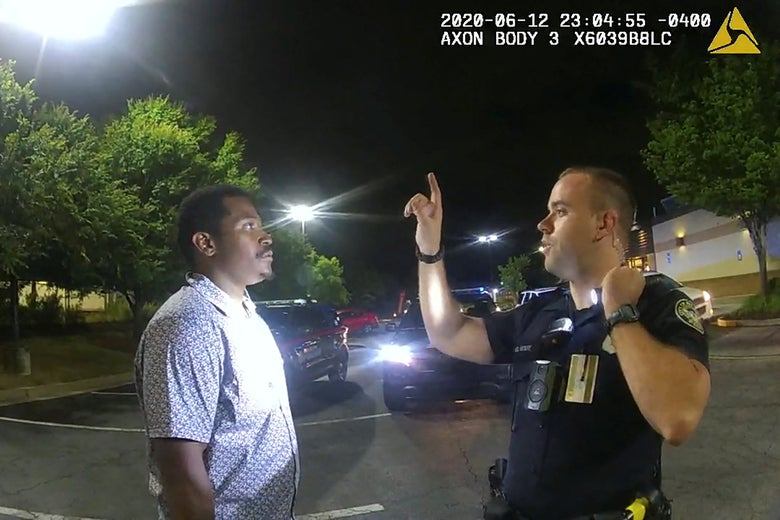
Protests intensified in Atlanta after a police officer shot 27-year-old Rayshard Brooks in the parking lot of a Wendy’s fast-food restaurant. The encounter was caught on surveillance camera and by a witness. Police approached Brooks after he had fallen asleep in his car. The police questioned Brooks, patted him down and gave him a breathalyzer test. Witness videos, surveillance footage, bodycam and dashcam footage show the officers engaged Brooks without incident for 41 minutes before the encounter turned fatal.
Atlanta Police Department officer Devin Brosnan arrived at the Wendy’s restaurant to investigate a report of a man asleep in a car which was blocking the drive-through lane. Brosnan awakened Brooks and told him to move the car to a parking space and take a nap. Brooks fell asleep again without moving the car prompting Brosnan to again wake Brooks and instruct him to park the car. Brosnan checked Brooks’s driver’s license and radioed for assistance from an officer certified to conduct driving under the influence investigations. Officer Garrett Rolfe arrived at 10:56 and, with Brooks’s permission, performed a pat-down search for weapons, a field sobriety test, and a breathalyzer test. Brooks appeared impaired and said he had consumed one to one-and-a-half drinks and denied driving or being too drunk to drive. The Breathalyzer registered a blood alcohol level of 0.108%, above the legal limit of 0.08%. Brooks asked to leave his car in the parking lot overnight and walk to his sister’s house a short distance away.
At 11:23, Rolfe told Brooks: “All right, I think you’ve had too much to drink to be driving. Put your hands behind your back for me”; he and Brosnan then moved behind Brooks to handcuff him. Brooks tried to break free and he and the officers scuffled on the ground. During the struggle Brosnan drew his Taser, but Brooks wrested from him and fired it toward Brosnan before attempting to run away. Brosnan says the Taser contacted him and he struck his head on the pavement. Rolfe drew his own Taser and shot Brooks with it. Brooks fled through the parking lot with Brosnan’s Taser still in hand as Rolfe pursued him and fired again with his own Taser. While still running, Brooks turned to fire the second shot of Brosnan’s Taser – capable of two shots before being reloaded – over Rolfe’s head. According to prosecutors, Brooks and Rolfe were 18 feet apart when Rolfe dropped his Taser, drew his handgun and shot Brooks once in the mid-back and once in the buttocks; a third shot struck a nearby vehicle, narrowly missing its three occupants. According to prosecutors Rolfe then declared, “I got him”.
Within 24 hours of the shooting, Mayor Keisha Lance Bottoms said that she did not believe it was justified, leading to Rolfe’s firing, Brosnan being placed on administrative duty and the resignation of the city’s police chief, Erika Shields. The county medical examiner rule Brooks’ death a homicide and Georgia Bureau of Investigation opened an investigation. The Fulton County District Attorney said Brooks did not present himself as a threat and appeared almost jovial during the encounter. He announced 11 charges against Rolfe: felony murder, five counts of aggravated assault, four police oath violations, and damage to property. He said Rolfe should have been aware that the Taser Brooks had taken posed no danger, as after being fired twice it could not fire again. He also said that Rolfe and Brosnan did not provide timely medical aid to Brooks and that before they did, Rolfe kicked him and Brosnan stood on his shoulders. The district attorney said it was a violation of department policy for Rolfe to begin handcuffing Brooks before telling him he was being arrested.
Read more
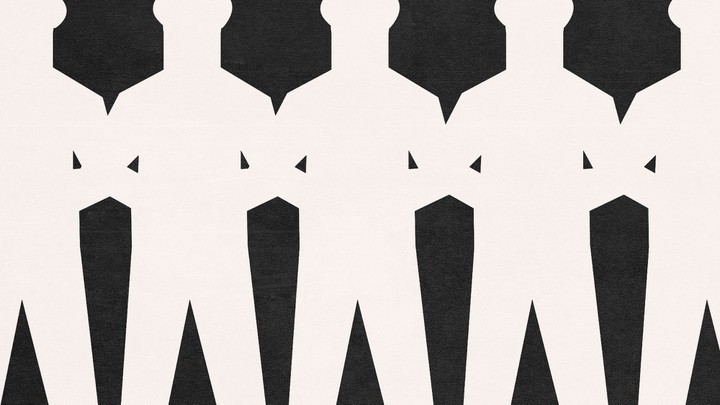
With mass uprising over police brutality showing no signs of abating, more policy changes are taking shape around the country. San Francisco announced last week that trained, unarmed professionals will respond to noncriminal calls instead of police. Colorado lawmakers passed a bill to introduce sweeping police changes, including banning choke holds and requiring officers to intervene if they see excessive force being used. Boston Mayor Marty Walsh said he will reallocate $3 million from the police department’s budget toward public health initiatives. The Minneapolis City Council unanimously passed a resolution to replace the police department with a community-led public safety system. Minneapolis Councilmember Alondra Cano said, “We acknowledge that the current system is not reformable, that we would like to end the current policing system as we know it.”
Connecticut Governor Ned Lamont imposed a series of reforms on the Connecticut State Police, including a ban on choke holds, a mandate that officers use body cameras and dashboard cameras, and restrictions on a program that funnels military equipment to local law enforcement. Iowa Governor Kim Reynolds signed a police reform bill into law, prohibiting the use of a choke hold in an arrest “except when a person cannot be captured any other way or has used or threatened deadly force” and preventing an officer from being hired in Iowa if they have a previous felony conviction, were fired for misconduct, or left before they could be fired for misconduct. The bill also requires annual anti-bias and deescalation training for law enforcement and allows the Iowa Attorney General to prosecute officers for a criminal offense resulting in the death of a human being.
Michigan State Senator Jeff Irwin introduced Senate Bill 945 which would require the addition of “implicit bias, deescalation techniques, and mental health screening” as part of the Michigan Commission on Law Enforcement Standards certification process for new law enforcement officers. The bill was drafted before the death of George Floyd in response to the broader problem of police brutality and passed the State Senate unanimously on June 4. Kansas City Mayor Quinton Lucas announced a series of police reforms, including whistle blower protections, independent review of officer-involved shootings, and use of body cameras by police officers. New Jersey has banned police departments from using choke holds and similar neck and carotid restraints. According to Attorney General Grewal’s order, “Because these tactics create a substantial risk of death or serious bodily harm, officers who cause a subject’s death or injury while performing them face potential criminal liability” except when “deadly force is necessary to address an imminent threat to life”.
Meanwhile, counties and cities across the country, including Cleveland, Denver and Indianapolis, are declaring racism a public health crisis. Seattle City Council member Kshama Sawant is calling for a section of downtown known as the Capitol Hill Autonomous Zone to remain permanently in community control. Protesters took over several city blocks last week after the Seattle Police Department abandoned its Capitol Hill precinct and stopped trying to violently disperse marches. The Seattle City Council voted unanimously to ban police use of tear gas and choke holds.
The New York Police Department announced it is dismantling its plainclothes anti-crime unit and the 600 officers in the unit will be reassigned. In 2018, news outlets reported plainclothes anti-crime officers had been involved in 31% of fatal police shootings in New York since 2000. Meanwhile, Albuquerque, New Mexico, has announced plans to create a new civilian department made up of social workers and others to respond to non-emergency 911 calls. In Georgia, the state Legislature reopened with a call to pass a hate crimes bill. Georgia is one of four states with no hate crime laws.
Read more
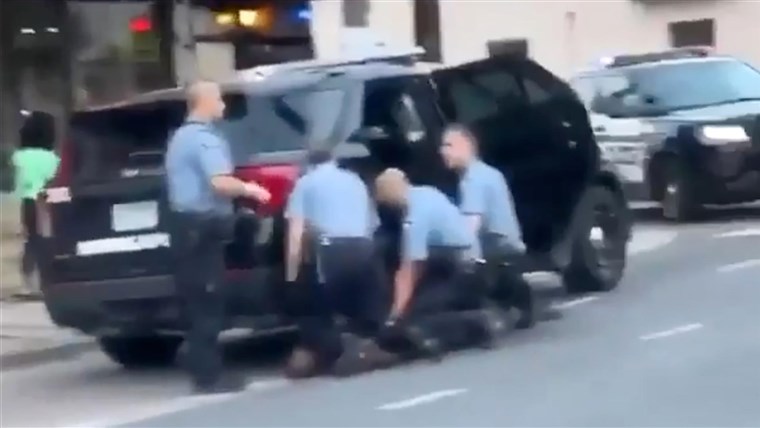
Protests erupted in Minneapolis, Minnesota after video footage of the death of George Floyd, 46, went viral. Floyd died after being arrested by police outside a shop on May 25th on a report he used a fake $20 bill to buy a pack of cigarettes from Cup Foods, a grocery store. The video shows now fired police officer, Derek Chauvin, kneeling on Mr Floyd’s neck while he was laying on his stomach in the street with his hands cuffed behind his back. Floyd can be heard repeatedly saying “Please, I can’t breathe, please, please officer don’t kill me” for the 8 minutes and 46 seconds that Officer Chauvin held him pinned to the ground with his knee on the back of Floyd’s neck.
In the video of the incident, a bystander tells the police: “You got him down. Let him breathe.” After Floyd says, “I’m about to die,” Chauvin tells Floyd to relax. The police ask Floyd: “What do you want?” Floyd repeats: “I can’t breathe.” Floyd continues: “Please, the knee in my neck, I can’t breathe.” The policemen taunt Floyd to “get up and get in the car,” to which Floyd replies: “I will… I can’t move.” Floyd also cries out: “Mama!” He then says “My stomach hurts, my neck hurts, everything hurts,” and requests water. The police do not audibly respond to Floyd. Floyd begs: “Don’t kill me.” A bystander points out that Floyd is bleeding from the nose. Another bystander tells the police that Floyd is “not even resisting arrest right now.”
The day after Mr. Floyd’s death, the Police Department fired all four of the officers involved and the Hennepin County attorney, Mike Freeman, announced murder and manslaughter charges against Derek Chauvin, the officer who can be seen most clearly in witness videos pinning Mr. Floyd to the ground. Chauvin kept his knee on Floyd’s neck for eight minutes and 46 seconds, according to the criminal complaint against him. Video show that Chauvin did not remove his knee even after Mr. Floyd lost consciousness and for a full minute after paramedics arrived at the scene. Floyd’s last words have been compared to those of Eric Garner who uttered the words “I can’t breathe” eight times before he died while being placed in a chokehold by Officer Daniel Pantaleo in July 2014.
Derek Chauvin had 18 complaints over his 19 year career as a police officer with 2 resulting in disciplinary actions. Chauvin has been the subject of several internal complaints as well. George Floyd and fired police officer Derek Chauvin knew each other before the fatal encounter. Chauvin worked outside security at a bar for 17 years while Floyd worked security inside the bar. Floyd grew up in Houston Texas and 13 years ago in 2007 he was charged with armed robbery in a home invasion in Houston In 2009 he was sentenced to five years in prison as part of a plea deal, according to court documents. In 2014 he moved to Minneapolis looking for work and a new start. Videos he posted on social media while under stay at home orders show him denouncing violence and encouraging his community to find another way.
While the protests started in Minnesota, they quickly spread across the globe. Demonstrators gathered in London, France, Germany, Denmark, Italy, Syria, Brazil, Ireland, Poland, Mexico, Canada and New Zealand, among other places, to protest against police brutality in solidarity with the US crowds. Demonstrators have gathered in the thousands in many major cities worldwide. Many protestors remain peaceful but their message has been marred by the violence, looting and vandalism taking place in cities across the US.
Read more

There are now over 5 million confirmed cases of the coronavirus and more than 325,000 known deaths around the world. Over 2 million people around the world have recovered from the virus. Despite the US having less than 5% of the world’s population, there are almost 1.5 million confirmed cases with over 100,000 deaths, representing over one-quarter of all fatalities and almost one-third of the confirmed cases. Over 450,000 people have recovered from Covid 19 but there are now cases in the US of people that have been re-infected, meaning they did not develop antibodies to build immunity with their first infection.
Forty-eight states will be at least partially reopened this week as health experts continue to warn of the danger of a hasty end to lockdowns. Each state has their own guidelines on what businesses have reopened and a timeline on further openings. There are 17 states that have seen an uptick in new cases since reopening. Officials from the World Health Organization say those who ignore measures such as social distancing are at risk of seeing a resurgence of the coronavirus. They also advise people to wear face masks when they are in groups. While coronavirus generally doesn’t spread outdoors as easily as it does indoors, there’s still a risk with any cramped crowd — especially because the virus can spread by just talking.
A cluster of new cases emerged after a swim party in Arkansas. In Atlanta, several recent prep school graduates also tested positive for the coronavirus, including one who had friends over for a graduation party. NY Governor Andrew Cuomo confirmed new COVID-19 cases are predominantly coming from people leaving their homes to shop, exercise or socialize. Meanwhile, in California, Orange County’s coronavirus cases continue to mount, with over 4,000 cases reported. COVID-19 cases are on the rise in Texas, with 1,800 new infections reported last Saturday — the highest single-day increase in Texas so far. South Dakota has also seen a spike in cases since reopening.
Some states are now seeing drops in the number of confirmed cases. New Jersey, one of few states that had one of the strictest and longest stay at home orders, has seen a decrease in cases. This appears to be relatively bright news for hard-hit New Jersey, second in the country only to New York for the number of total reported cases with over 143,600 confirmed and over 10,000 deaths.
Missouri also saw a drop in cases when they began allowing all businesses to reopen May 4, but then an increase during the second week of reopening. Businesses were allowed to reopen provided they could abide by certain social distancing guidelines. Indoor retail businesses must limit their number of customers to no more than 25% of normal capacity, and local communities can choose stricter rules if they choose. Missouri has over 11,000 cases and over 600 deaths. Idaho, which only has around 2,500 cases, also saw a decrease in reported cases.
As each state opened, many leaders stressed the importance of following the social distancing guidelines but left responsibility up to it’s’ citizens. The CDC recommends wearing cloth face coverings in public settings where other social distancing measures are difficult to maintain (e.g., grocery stores and pharmacies) especially in areas of significant community-based transmission. They say that maintaining 6-feet social distancing remains important to slowing the spread of the virus. CDC is additionally advising the use of simple cloth face coverings to slow the spread of the virus and help people who may have the virus and do not know it from transmitting it to others. Cloth face coverings fashioned from household items or made at home from common materials at low cost can be used as an additional, voluntary public health measure.
Read more
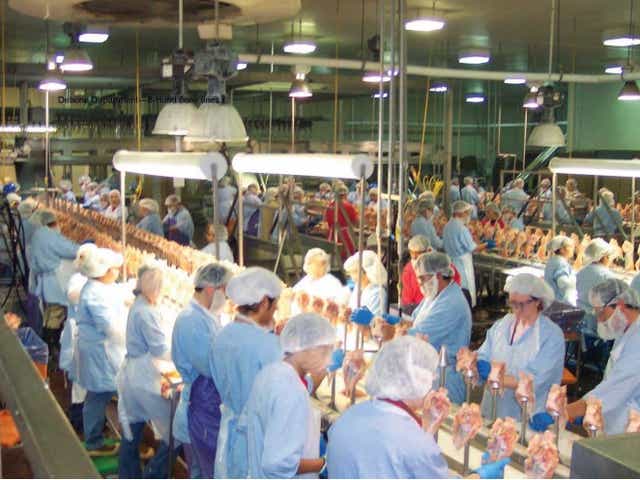
The United Food and Commercial Workers Union, the country’s largest meatpacking workers’ union, is condemning the reopening of 14 meatpacking plants under a recent executive order by the US Administration. The union is calling for CDC coronavirus safety guidelines to be made mandatory, as at least 30 meatpacking workers have died of COVID-19 and over 10,000 have been exposed to or infected by the coronavirus. The industry work practices under normal circumstances tend to put workers in close proximity to each other, working at high speed as they cut up animal carcasses.
The pandemic caused at least 30 meatpacking plants to temporarily close over the past two months, resulting in a 40% drop in pork production capacity and a 25% drop in beef production capacity, the union said. The U.S. Agriculture Department said 14 plants that had closed due to outbreaks of the virus were in the process of reopening this week. The 14 plants included a Smithfield Foods Inc pork facility in Sioux Falls, South Dakota, that started operating on May 7 and another in Waterloo, Iowa, that Tyson Foods said earlier in the week would resume limited operations. The agriculture department also said meat facilities operated by JBS USA [JBS.UL] in Minnesota and Wisconsin, and six other Tyson plants were reopening.
UFCW has previously said more protective equipment and testing would be required to open the plants. But as plants reopened without these measures in place, UFCW International President Marc Perrone criticized the decision. “Today’s rush by the Trump Administration to re-open 14 meatpacking plants without the urgent safety improvements needed is a reckless move that will put American lives at risk and further endanger the long-term security of our nation’s food supply. Since the executive order was announced, the Administration has failed to take the urgent action needed to enact clear and enforceable safety standards at these meatpacking plants.”
Health guidelines issued by CDC and OSHA to help reduce the spread of Covid-19 in slaughterhouses includes face coverings, health training in multiple languages, and more distancing between workers. Processing lines in meat plants typically run at high speeds, with employees eviscerating animals inches apart from each other. Slowing lines down and spreading workers out will undoubtedly increase the cost of producing meat, but Perry says it’s a small price to pay to protect their lives. CDC is also asking meat plants to do away with the contentious practice of offering “attendance bonuses,” in which companies offer hundreds of dollars of incentives to workers on the condition that they don’t miss their shifts.
The common criticism of OSHA and CDC’s Covid-19 guidance to meatpackers is that it’s entirely optional. This has resulted in an inconsistent patchwork of protections by plant and by state which leaves workers at risk for other outbreak. Unions are asking for standardized workplace protections against airborne diseases like Covid-19. Such requirements wouldn’t be without precedent. In 2010, following the H1N1 pandemic, OSHA began to draft mandatory guidelines to reduce the spread of viruses that spread through air and respiratory droplets. That rulemaking was finalized in 2017 but was halted during the change in US Administration.
Read more
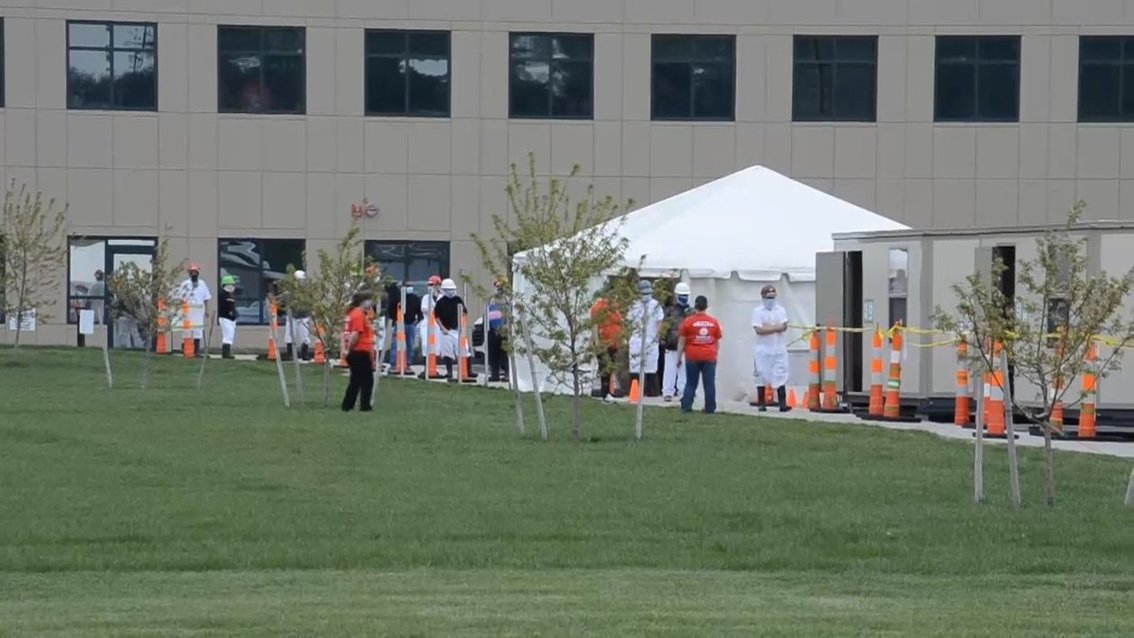
In St. Joseph Missouri, 422 workers at a Triumph Foods pork plant have tested positive for the coronavirus and all of them were asymptomatic, according to state health officials. After nearly three dozen workers at the plant became infected last month, the Missouri Department of Health and Senior Services tested all asymptomatic workers at the plant from April 27 to May 1. The testing found that 422 of 2,367 workers tested positive despite showing no symptoms.
Those workers have been advised to self-isolate for 10 days before returning to work, according to federal health guidelines. The plant remains open, along with a mobile testing site operated by Northwest Health Services. The company just confirmed that one employee, a man in his 40s with underlying health issues has died of Covid 19. The company said he was one of the first workers to be tested and had not returned to work since April 21.
“While individuals tested during this initiative did not show COVID-19 symptoms, lab results received thus far indicate that around 17% tested positive for the virus. Of all the positive test results received thus far, over 90% have been collected from asymptomatic people,” explained Mark Campbell, CEO of Triumph Foods. Employees with positive results were notified and asked to self-isolate. The state health department began tracing measures and have confirmed that nearly 200 people were infected with Covid 19 by some of the asymptomatic Triumph workers. Meanwhile, the state continues to work to contact trace the affected employees and now those they have infected as well.
Missouri Governor Parsons issued a state wide stay at home order on April 6th yet the asymptomatic employees still infected almost 200 people in the counties they live in. Kansas City and Wyandotte County, where the new cases were confirmed, have been under stay at home orders issued by Mayor Lucas since March 24. Despite those orders being issued first and ending later than the state wide order, they still had a spike in cases due to the outbreak at Triumph Foods.
Outbreaks have become common at other meat plants across the U.S., infecting thousands of workers, leading to the closure of some plants and prompting meat shortages. Several big grocery chains this week were restricting customer purchases of meat, and Wendy’s was unable to serve hamburgers at some locations due to shortages. Other packing plants are beginning to test all employees like Triumph Foods, which industry leaders say is critical to assure employees that it’s safe to go back to work and to grow data sets to show how the virus works.
For most people, the coronavirus causes mild or moderate symptoms that clear up after two to three weeks. For some, especially older adults and people with existing health problems, it can cause more severe illness, including pneumonia. Because the virus is still circulating through the community, it’s important to maintain social distancing, mask wearing and hand-washing, even after stay-at-home orders are lifted.
Dr. Aamina Akhtar, Mercy Hospital South chief medical officer and an infectious disease specialist said “The next two to three weeks will be telling, and will really give us an idea whether human actions will lead to an increased number of cases. Our actions today will affect the community around us. It’s a big social responsibility and I hope we are ready.”
Read more
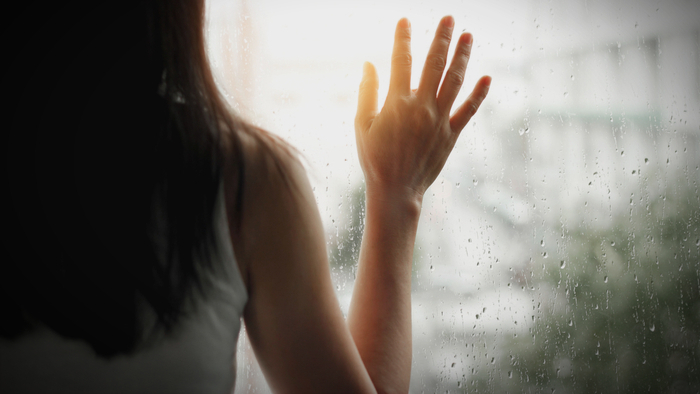
As countries impose lengthy lockdowns to combat the spread of the coronavirus, reported cases of domestic abuse have spiked around the world. In the weeks since populations worldwide have been directed to “stay home” to prevent the virus’s spread, cases of domestic violence have surged — and that’s reported cases. Women who are victimized are now confined to isolated homes with abusive partners whose coercive and physically violent tendencies are enabled and further inflamed by economic stressors. Supportive community ties are severed, while emergency services, shelter systems, and social services are overwhelmed and congenitally underfunded.
Millions of Americans are not safe from violent abuse at home and now the federal, state and local governments are telling everyone to stay home – for their own safety. For some people, going to work may be their only reprieve from emotional abuse and violence. For others, the only place their children are safe from abuse is at school. Now they have been told to stay at home. Few jobs are completely safe from the economic fallout of the coronavirus crisis and stressed abusers have their targets at home.
According to statistics released by the U. N., reports of domestic violence in France rose 30% following the country’s lockdown on March 17; during the first two weeks of lockdowns in Spain, the emergency number for domestic violence received 18% more calls; and help lines in Singapore have received 30% more calls. In the US, law enforcement agencies have seen domestic violence cases rise up to 35% in recent weeks. Keeping in mind, that 50% of domestic abuse cases go unreported.
Advocates fear domestic violence survivors may have trouble getting away from their abusers and are calling the rise an epidemic during a pandemic. They are urging communities around the world to make sure resources are readily available for survivors. Even before the pandemic, an average of 20 people in the United States experienced physical domestic violence every minute. Research shows 1 in 4 adult American women and 1 in 7 adult American men have experienced some type of severe violence – including being hit with something hard, being kicked or beaten, or being burned on purpose – at the hands of an intimate partner.
Advocates are already seeing a pattern of increasing domestic violence around the world, correlating with the timing of social distancing lockdowns. In Seattle, one of the first U.S. cities to have a major outbreak, the police saw a 21% increase in domestic violence reports in March. In Texas, during March the Montgomery County District Attorney saw a 35% increase in domestic violence cases. Police around the country are adapting their domestic violence response plans to prepare for the expected increases and to ensure victims can get help even with restrictions on public movement.
Many organizations that serve survivors of domestic violence may also struggle to stay afloat during the pandemic. Many child-protective organizations are experiencing strain with fewer workers available, so they may be unable to conduct home visits in areas with stay-at-home orders. While such operational changes may lead to inaccurate reporting of child abuse and neglect, many advocates are expecting a surge in cases to continue to rise while they’re resources are still limited during the pandemic. The recent US$2 trillion federal CARES Act included assistance for nonprofits that provide support for domestic violence victims, letting them apply for business loans and help meeting payroll.
Read more
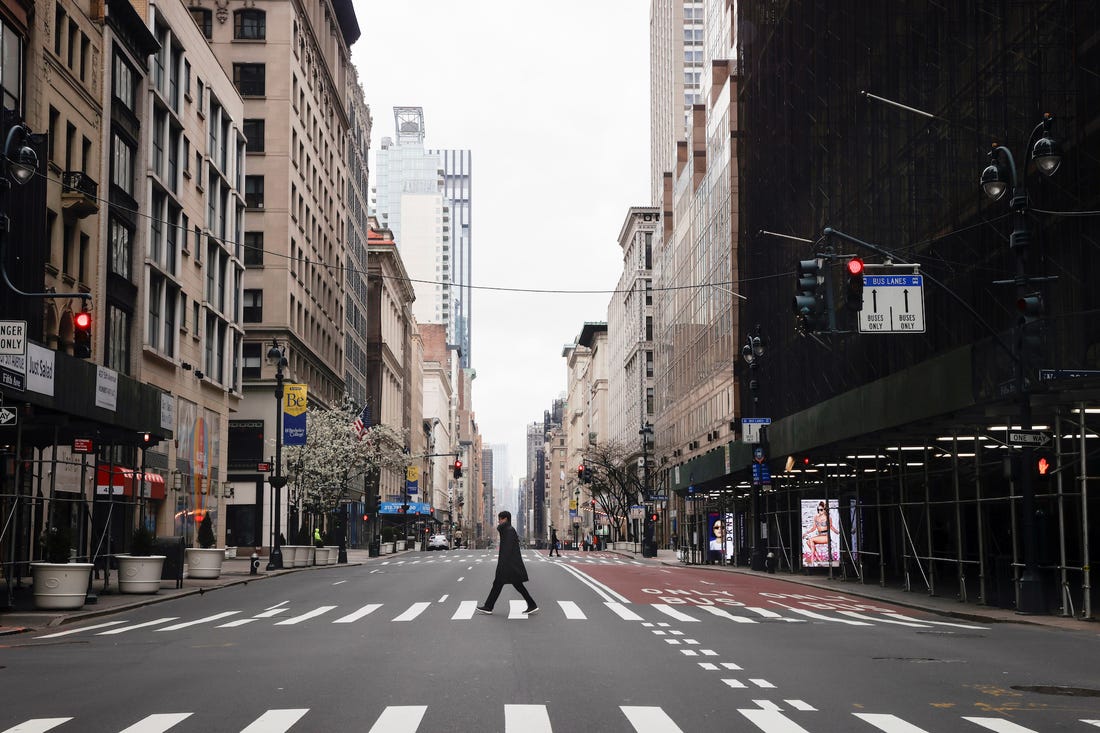
While the US has become the global epicenter for the Covid-19 pandemic, New York State is the US’s epicenter, far leading in confirmed cases and deaths. Over 200,000 of the confirmed cases in the US are in New York and over 10,000 people in the state have died. Almost 110,000 of those cases are concentrated in New York City. About 25% of New York State’s COVID19 deaths are residents of nursing homes and adult care facilities. There are about 96,000 residents at 613 licensed nursing homes in New York State. More than 5,500 residents at 338 nursing homes have tested positive for the coronavirus.
For the first time since the coronavirus crisis struck New York, there were fewer admissions to the intensive care unit on Thursday, April 9th than the day before. It’s one of a number of encouraging signs that the worst may have passed. The governor said that he is “cautiously optimistic” that we are slowing the infection rate. He cited a dramatic decline in hospitalizations and even a negative statistic for the first time in the ICU.
Governor Cuomo said that social distancing policies and compliance by the public greatly flattened the curve after the death toll stabilized but he warned the situation is still dire and New Yorkers would need to maintain strict measures to continue the trend. Gov. Andrew Cuomo: “If we are plateauing, we are plateauing at a very high level, and there’s tremendous stress on the healthcare system. And to say to this healthcare system — which is at maximum capacity today, right? This is a hospital system where we have our foot to the floor and the engine is at red line and you can’t go any faster. And by the way, you can’t stay at red line for any period of time, because the system will blow.”
Cuomo said schools and nonessential businesses will now remain closed and he announced fines for violating social distancing rules would increase from a maximum of $500 to $1,000. As of today, New York State has nearly 5,000 recorded deaths from COVID-19, with over 131,000 confirmed cases and over 16,000 hospitalizations. While the total number of statewide cases of Covid 19 hospitalizations is plateauing, confirmed cases are rising in some areas as they fall in others.
Cuomo announced that the state would issue a number of additional guidelines, including requiring that cloth masks be provided, cost-free to essential workers, by businesses, and the expansion of who is eligible to receive an antibody test. Cuomo again said testing would be the key to restarting the economy. It’s been almost a month since stores around the state have been shut, its employees home and out of work, and trying to apply for unemployment benefits. This week 347,000 New Yorkers filed for unemployment, bringing the number of jobless claims since March 14 to over 800,000.
When asked when he thought things would return to normal for the hard hit state, Cuomo said “As far as when things could go back to normal, well, when will we return to normal? I don’t think we return to normal. I don’t think we return to yesterday, where we were. I think if we are smart, we achieve a new normal.”
Read more
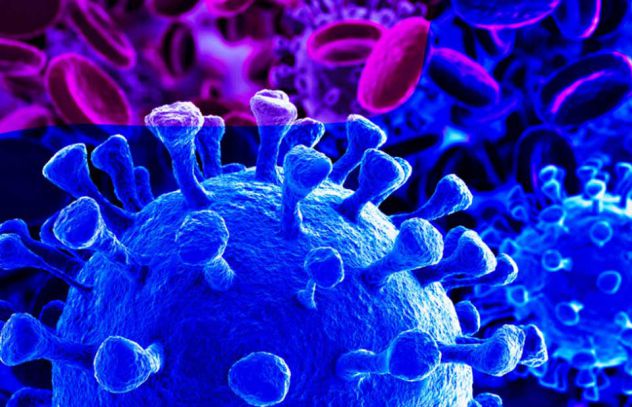
The coronavirus pandemic continues in almost every corner of the globe, with the number of confirmed COVID-19 cases worldwide surpassing 1 million people — though the true number is certain to be far higher due to a critical lack of testing globally. The largest number of cases is in the United States with over 350,000 confirmed. Over 10,000 people in the US have died of Covid-19 as the virus continues to spread.
In Europe, COVID-19 has pushed hospitals across the continent past their breaking points. Spain has reported over 120,000 cases and their death toll topped 10,000. In the U.K., London’s ExCeL convention center has been converted into an enormous field hospital with plans to treat up to 4,000 COVID-19 patients. Over 2,300 people have died from the disease across the U.K.
In Italy, there are over 100,000 confirmed cases and their COVID-19 deaths have topped 15,000. It’s been reported that Italy’s true toll is far higher because the country can’t spare the resources to test every dead body. U.S. Vice President Mike Pence said models predict the United States faces a trajectory of COVID-19 deaths similar to Italy’s. The computer model used by the White House projects close to 82,000 COVID-19 deaths in the United States by August 4, assuming the country implements full social distancing until the end of May.
The 81,766-death projection is a slightly less grim figure than the 93,531 cited earlier by the administration. The model projects that the country may need fewer hospital beds, ventilators and other equipment than previously estimated, and that some states may reach their peak of COVID-19 deaths sooner than expected. Not all states are using the federal government’s forecasting model.
While the White House projects that coronavirus cases in the nation’s capital would peak later this month, the local Washington, DC government is relying on a different computer model that says it won’t peak until late June or early July. Health experts warn against early optimism and say it’s best to prepare for worst case scenarios.
Experts say that pandemic modelling is almost never precise and the Covid-19 pandemic, the uncertainty in the projections is because of lack of access to good data coupled with the fact that we just don’t know enough about the coronavirus. Another factor that adds to the uncertainty is how people will behave and what kinds of policies will be enacted to change contact patterns in the weeks and months ahead. The ranges estimated really depends on how much people actually adhere to social distancing policies and how quickly these policies are issued.
Read more

Dr. Anthony Fauci, speaking on CNN’s “State of the Union”, offered his prognosis as the federal government weighs rolling back guidelines on social distancing in areas that have not been as hard-hit by the outbreak at the conclusion of the nationwide 15-day effort to slow the spread of the virus. The U.S. government’s foremost infection disease expert says the United States could experience more than 100,000 deaths and millions of infections from the coronavirus pandemic.
The US has become the epicenter with about 125,000 cases of COVID-19 in the U.S. and over 2,100 dead as of March 29, 2020. Most people who contract COVID-19 have mild or moderate symptoms, which can include fever and cough but also milder cases of pneumonia, sometimes requiring hospitalization. The risk of death is greater for older adults and people with other health problems. Hospitals in the most afflicted areas are straining to handle patients and some are short of critical supplies.
The US president has suggested that a target date for reopening the U.S economy, which has been battered by the coronavirus outbreak, is April 12, Easter. But public health officials warn that lifting restrictions too soon could lead to more deaths and further damage the economy. To limit the spread of the coronavirus, the Centers for Disease Control and Prevention has issued social distancing guidelines and called for gatherings of more than 10 people to be canceled, while governors have ordered residents in their states to remain in their homes and ordered nonessential businesses to close.
The CDC has issued a domestic travel advisory for New York, New Jersey and Connecticut. “Due to extensive community transmission of COVID -19 in the area, CDC urges residents of New York, New Jersey, and Connecticut to refrain from non-essential domestic travel for 14 days effective immediately,” the CDC said in a statement. “This Domestic Travel Advisory does not apply to employees of critical infrastructure industries, including but not limited to trucking, public health professionals, financial services, and food supply.” The CDC also noted that the governors of the three states would “have full discretion to implement this Domestic Travel Advisory.”
With more than 124,000 cases and 2,046 deaths nationwide, the three states make up more than half of the cases and nearly half of the deaths. New York State has over 55,000 confirmed cases and over 2,000 deaths. New Jersey has over 11,000 confirmed cases and 140 deaths. Connecticut has over 1,200 confirmed cases and 33 deaths. Most of the Connecticut cases are in Fairfield County where many residents commute into New York City for work.
Read more












